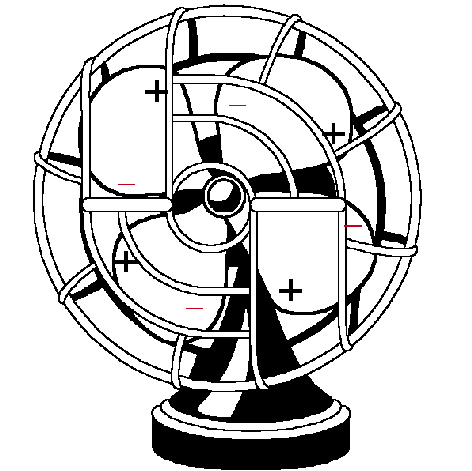By:
Moustafa Elhoushi
1998
If this theory is true,
the history of technology will change! A fan can move at a fraction of
the speed of light!
Bring a ruler, rub it
on to your hair and put it next to a small piece of paper. The paper will
be attracted by the ruler. This is how this machine works….
It is possible to make
a fan turning ten times the speed of concorde! Look below. You can see
a fan. The( - ) means cathode, and the ( + ) means the anode. The cathode
terminal is always attracted to the anode. Two different charges on one
swing won't be able to attract each other, because there is an insulator
between the two charges. That means, the electrons will have to travel
from the other way, towards the anode of the swing nearby. When one swing
moves towards the other, the other swing will be attracted by another swing
and so on. That means, that all of the swings will "chase" each other.
In other words, it'll move like a fan. If the swings are connected by conductors,
and if the swings themselves are light and near each other, the fan will
revolve at an incredible speed. The speed of the fan can exceed the speed
of sound, perhaps faster. If the distance between the swings is as small
as one nanometre, the speed might exceed 1% the speed of light (in other
words, more than 1,000,000 kilometres per hour!). Nowadays, electricity
is produced when copper turns between 2 magnets, the south and north. Magnetic
fields will be produced if a metal revolved between anode and cathode,
you can use this motor to revolve between the 2 charges. Electricity will
also be produced if the motor revolved between south and north magnets.
I don't deny that there might be obstacles facing anyone trying to invent
this fan but if someone managed to invent this motor, we'll be able to
produce heat, fire, electricity, and magnetism and will move wheels for
vehicles!
These equations prove
that my theory is correct....
F= Q1Q2/R
F=Force, Q=Charge,
R= Radius, or Distance
In the fan, the charges
will be 1000 Coulombs and the distances between them will be 1 nanometre
or 1 billionth of a metre.
F= 1000 x 1000/ 1billionth
F= 1million/ 1 billionth
F= 1,000,000,000,000,000N
F=ma
We know that F= 1,000,000,000,000,000
N. If the fan is light, let's say it is 5kg, then the acceleration will
be:
a= F/m
a= 1,000,000,000,000,000
N/5kg
a= 200,000,000,000,000
m/s/s
If the fan is in a vacuum,
there will be no oxygen to produce fire or air resistance to slow it down.
If this fan is to be used in a rocket, we can surround it with a lot of
oxygen so that there will be enough fire or up thrust.


